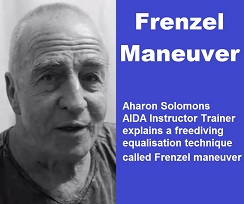 The idea for this video came by way of a chance encounter, it was I admit something that had been rattling around in my head for a long time, but I have a great talent for procrastination. Several people had suggested I tackle the subject. The “Frenzel“, it is a basic technique specific to freediving. It came to my attention, many people fail the AIDA 2 star course that has a depth minimum of 16 mts by failing to cross this hurdle. People were coming to me after courses, having tied themselves in knots worrying about their soft palate their epiglottis and tongue position. All unneccessairy! Get the tongue action right, and the rest follows automatically. This – you can teach yourself with a flash light in front of a mirror with a bit of persistence.
The idea for this video came by way of a chance encounter, it was I admit something that had been rattling around in my head for a long time, but I have a great talent for procrastination. Several people had suggested I tackle the subject. The “Frenzel“, it is a basic technique specific to freediving. It came to my attention, many people fail the AIDA 2 star course that has a depth minimum of 16 mts by failing to cross this hurdle. People were coming to me after courses, having tied themselves in knots worrying about their soft palate their epiglottis and tongue position. All unneccessairy! Get the tongue action right, and the rest follows automatically. This – you can teach yourself with a flash light in front of a mirror with a bit of persistence.
There is so much confusion out there – it sounds like the tower of Babel, this is what at first put me off adding just another opinion to mess.
Then I met Nadav Harel, who came to train with me. He is a very talented film maker, who I found intimidating at first, and for a year with the patience of a Saint added his voice to Alina’s, who quite rightly was beginning to lose patience with me. Anyway here is my small offering. It was a team effort but any mistakes or short comings are solely my own.
I realise this does not cover the entire subject ,but that would be a very long video and I was warned this was approaching the desirable limit. I wanted to include how to self analyze during the dive in order to understand why things were not working perfectly eg. Air in the mouth but still could’nt equalise – Soft palate shut – usually due to not equalising frequently enough. Or head position – looking at the bottom. Or tension having crept in etc`.
Having said all this, I do not teach the Frenzel even in combination with the mouthfill for very deep diving. I teach another technique, using the cheeks and not the tongue, I will be discussing this in my next video which will be “how to train for depth and avoid lung squeezeâ€.
Again I want to thank Nadav who produced the video and Alina who helped in the post production phase and added the sub titles for those who have trouble with my accent and generally supported the project throughout. I understand that with a click of a button the sub titles can be translated into several languages.
I do hope this helps someone out their or even gives another opinion to an Instructor.
I also hope that this will not become a self help tool that might stop or delay someone attending a course. The main objective of the course is to learn how not to kill yourself and that is certainly worth your time and money.
Subtitles in English are available on the video. click CC for captions, and it’ll let you even translate it. And of course you can enlarge it.
A very useful video that succinctly covers all of the salient points of how to correctly perform the Frenzel maneuver.
Hi, really good video. I have a question, why does air goes out of one of my eyes when I’m equalizing?
Very usefull video especially for beginners, I’m teaching about the same way.
But there are 2 anatomical errors in your explanations, unfortunately I hear them too often, but are not significant for the rest of the theory.
One is the confusion of the epiglottis with the glottis. I suppose you wanted to speak about the glottis. The epiglottis has not to be closed during Frenzel like you told, or not necessarily. The disadvantage of closing the epiglottis is that it is mecanically combined with the opening of the top of the oeusophage tube, so air will or can leak in the stomach if you mobilize the epiglottis fully while doing Frenzel. the epiglottis is like a flap that close the trachea when swallowing to prevent food going down to the lungs. But the glottis which is the vocal folds has to be closed and controlled during Frenzel.
2nd point is the confusion of diaphragm and abdominals when you speaking about the Valsava maneuver. The diaphragme is a muscle like other, then it is working “contracting” in only one way, the other way is relaxed and is passive, so the diaphragm can not push air up, this work is made by the abdominals, diaphragme and abdominals and also intercostal muscle are antagonist paired, like biceps and triceps are.
Air going out of eyes when equalizing: that can happen to some people, air can be forced though nasolacrimal duct. A friend of mine has the same, he can expel smoke that way, or even liquid like milk, he is ready for freak shows.
Don’t worry too much about it, try to manage a good Frenzel maneuver, that is made very frequently, so you don’t have to force too much air at once if you have delay, preventing this way air leaking out of “eyes”